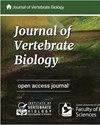Phenotypic trait variations in the frog Nanorana parkeri: differing adaptive strategies to altitude between sexes
IF 1.5
4区 生物学
Q2 ZOOLOGY
引用次数: 0
Abstract
Abstract. In many animals, changes in altitude drive adaptive variation in body size. However, how other phenotypic traits change when faced with different environments has been little studied in ectotherms. In this study, we selected the high Himalaya frog Nanorana parkeri as a model species for investigating the adaptive evolution of phenotypic traits that respond to altitude in both sexes. First, we found that body mass in populations at higher altitudes was lower than at lower altitudes in females, with no difference observed in males. Second, we found significant differences in fresh liver mass, fresh heart mass, and the ratio of liver mass to body mass with increasing altitude, while hindlimb length decreased with altitude in both sexes. Third, snout-urostyle length, hindlimb length, fresh heart mass and the ratio of heart mass to body mass showed significant negative correlations with increasing altitude in both sexes. In contrast, body mass showed a significant correlation with altitude in females but not males. On the other hand, the ratio of liver mass to body mass showed a significant correlation with altitude in males but not in females. Thus, the species displayed sex-specific organ-size variation along elevation gradients, which may trade-off in life history strategies among populations. We speculate that selection favours a larger heart and liver mass to maintain a higher respiratory rate and energy consumption as an adaptation to high-altitude environments.蛙的表型特征变异:不同性别对海拔高度的不同适应策略
摘要在许多动物中,海拔高度的变化会导致体型的适应性变化。然而,在外胚层中,其他表型性状在面对不同环境时如何变化的研究很少。在这项研究中,我们选择了高喜马拉雅蛙Nanorana parkeri作为模式物种,研究两性对海拔高度反应的表型特征的适应性进化。首先,我们发现,高海拔人群中女性的体重低于低海拔人群,而男性的体重没有差异。其次,我们发现,随着海拔高度的增加,新鲜肝脏质量、新鲜心脏质量以及肝脏质量与身体质量的比率存在显著差异,而后肢长度则随着海拔高度而减少。第三,鼻尿路长度、后肢长度、新鲜心质量和心体质量比与海拔高度的增加呈显著负相关。相反,女性的体重与海拔高度有显著相关性,但男性没有。另一方面,男性肝脏质量与身体质量的比值与海拔高度显著相关,而女性则不然。因此,该物种表现出沿海拔梯度的性别特异性器官大小变化,这可能会在种群之间的生活史策略中进行权衡。我们推测,选择有利于较大的心脏和肝脏质量,以保持较高的呼吸频率和能量消耗,从而适应高海拔环境。
本文章由计算机程序翻译,如有差异,请以英文原文为准。
求助全文
约1分钟内获得全文
求助全文

 求助内容:
求助内容: 应助结果提醒方式:
应助结果提醒方式:


